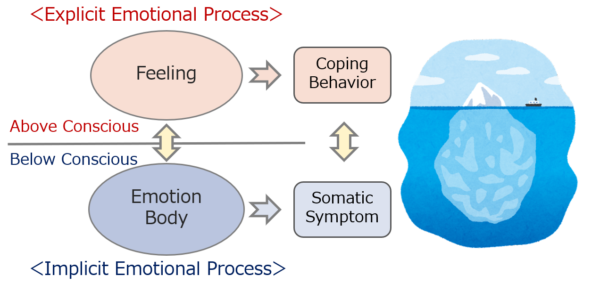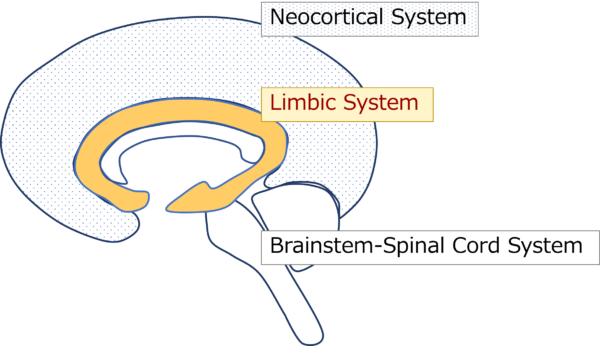Tendency to be unaware of emotions = alexithymia
There are various studies on this mechanism, but the most essential is a disorder of the “emotional processing”. Emotions and feelings are very important in human life. How do these disorders lead to physical symptoms?
“Feeling” and “Emotion”
“Emotion” refers to the lower and more primitive order functions (such as pleasure, displeasure, fear, anxiety, etc.) that are the source of higher order “Feelings” (joy, surprise, anger, disgust, sadness, etc.) 1). “Emotional Processing” is the function of maintaining mental and physical health by appropriately processing emotions and feelings caused by psychological distortions or stress that arise in our social life. (⇒ See Interoception and Psychosomatic Medicine (3): Emotion and Body.)

Conscious (explicit) vs. Subconscious (implicit) Emotional Processes
Lane R. define the processes involved in emotional processing as
- conscious emotional processes
= “explicit processes” - subconscious emotional processes
= “implicit processes”
(Lane, 2008).

The “conscious/explicit process” is a process about emotions that are literally made conscious. For example, it is a straightforward process where positive emotions are associated with healthy states and negative emotions are associated with unhealthy states. There are many studies similar to this, such as the relationship between laughter and health. When emotions are handled appropriately, such as through coping behaviors, physical and mental health can be maintained.
On the other hand, “subconscious/ implicit processes” are those in which negative emotions are prevented from being expressed or otherwise not properly processed on the conscious mind, leading to unhealthy somatic conditions as the emotions enter the subconscious process (the image of “emotions being pushed into the subconscious level “).
When negative emotions, such as sad feelings, arise,
(1) can we be healthy if we force ourselves to laugh or otherwise put ourselves in a positive mood? In other words, is it “laughing makes you happy,” or
(ii) is it “healthier to cry when you are sad” and not force yourself to suppress that experience or expression
is the debate.
Both have their own evidence and are not wrong. However, when negative emotions are not properly handled in the conscious level, explicit process, they enter the subconscious level, implicit process and lead to various physical symptoms of autonomic dysfunction, etc., as described below (see “Psychosomatic Diseases” ).
Brain Functions Related to Emotional Processing
From a neuroscientific perspective, the limbic system plays a central role in emotional processing and functions in cooperation with other related areas. As described in “Functional Levels of the Brain and Psychosomatic Medicine, the central nervous system can be divided into three major functional levels: neocortical, limbic, and brainstem-spinal 2).

Of these, the limbic system is involved in emotional processing and at the same time regulates the autonomic nervous system and the endocrine system, which are responsible for homeostasis 3) . The autonomic nervous system, which is distributed throughout the body, plays an important role in maintaining proper internal conditions of the body “autonomously and automatically”, including contraction and dilation of the airways, regulation of cardiac output and blood pressure, and promotion and suppression of gastrointestinal functions. For example, the autonomic nervous system is responsible for the increase in heart rate that occurs when we exercise without being aware of it.
The amygdala, a nucleus of the limbic system, and the cingulate cortex, a limbic cortex, are deeply involved in emotion processing, with the amygdala involved in the aforementioned “subconscious/ implicit process” and the cingulate cortex in the process of making emotions conscious (Morris, Ohman, & Dolan, 1998; Williams et al.)
Several physiological studies have shown that alexithymia is associated with functional abnormalities in these emotion processing processes. For example, alexithymia is associated with reduced activity in the anterior cingulate gyrus, insular cortex, medial prefrontal cortex, and other regions involved in emotion processing in response to emotional tasks involving facial expressions and emotional scenes (Kano et al., 2003).
It has also become clear that the physiological basis for this emotional process is deeply related to interoception, the system for perceiving the internal state of the body. For more information on the relationship between interoception and emotion/feeling, see Interoception and Psychosomatic Medicine (3): Emotions and the Body.
Coordination and Divergence of Functional Levels of the Brain
In this emotional process, functional coordination (connection) between brain levels is extremely important, as mentioned earlier, and in alexithymia, distortions caused by functional divergence or imbalance in the emotional processing process are thought to contribute to various physical symptoms through functional abnormalities in the limbic system, autonomic nervous, endocrine, immune system, and others.

These divergences can cause a variety of problems. Mind-Body Awareness through counseling, autonomic training, and other psychosomatic approaches facilitate this connection and are involved in the process of moving from such functional divergence to functional coordination.
(Kanbara K, Psychosomatic Labo/ LABs Psychosomatic Medicine, https://psychosom.net/emotional-process, Dec. 2024)
1) Regarding mental functions, the more clearly conscious, verbalized, and differentiated mental functions are called higher-order functions, while those that are not clearly conscious, verbalized, and undifferentiated are called lower-order functions.
2) The [neocortical system] is human-like: it is mainly responsible for higher mental functions that rise to consciousness, such as adaptation, creativity, and judgment.
The [brainstem-spinal cord system] is vegetative: it performs reflexes that do not involve mental activity, and functions essential to life, such as breathing and circulation, that are unconscious. It is, so to speak, a life-supporting system. Embryologically, this brainstem-spinal cord system is the oldest and is directly connected to the body. When only this part of the brain is alive and the rest of the brain is dead, it is in a so-called vegetative state.
The [limbic system] is located between this neocortical system and the brainstem, and is embryologically old, being the old cortex rather than the neocortex. It is anatomically located between the two, between the mind and the body, and functionally serves as a link between the mind and the body. While the neocortical system is responsible for human-like functions and the brain-spinal system for vegetative functions, the limbic system has animal-like functions: instinctive behavior, emotion, and homeostasis. On the level of consciousness, it is an intermediate level that is not clearly conscious but not completely unconscious.
3) The internal environment of an organism works to maintain a certain level of homeostasis regardless of changes in the external environment, which W.B. Cannon called “homeostasis.” In the real world, various physiological systems work dynamically and in concert to adapt to changes in the environment by changing their settings. McEwen et al. refer to such “dynamic homeostasis” as “allostasis,” a concept developed from the homeostasis.
Related Columns and Articles
- Interoception and Psychosomatic Medicine
- Interoception and Psychosomatic Medicine (2): Why is Interoception important?
- Interoception and Psychosomatic Medicine (3): Emotion and Body
- Alexithymia
- Research: Psychosomatic Research on Interoception
- Research: Psychosomatic Monitoring and Stress Assessment in Daily Life: The Key is Interoceptive Awareness
- Research: Emotional Process and Autonomic Function
Literatures
Kanbara, K., Fukunaga, M. Links among emotional awareness, somatic awareness and autonomic homeostatic processing. BioPsychoSocial Med 10, 16 (2016). https://doi.org/10.1186/s13030-016-0059-3
